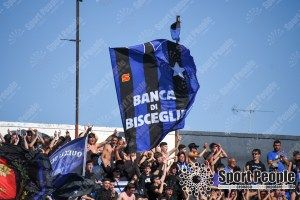It’s five in the morning on a bright Sunday in April. After having witnessed the Latina-Taranto match a few hours earlier, I set the car in motion to reach Puglia, where I return a few months after the Altamura-Andria match.
My destination is the “Gustavo Ventura” stadium in Bisceglie, which will be the scene of the heartfelt Bisceglie-Molfetta derby today. This is a very important match: the two cities are just 10 km apart, after several years the away match will be open to guests and whoever wins will challenge the Salento team Ugento in the Serie D final. Despite the Eccellenza groups Puglia are two, only one team will be able to obtain the pass for the Interregional. Ugento has already gained access to the decisive challenge having closed group B at the top of the standings with more than eight points ahead of Manduria, while in group A Bisceglie crossed the finish line in first position, but with seven points of waste on Molfetta, therefore only the play-off between the two Adriatic teams will be able to determine the challenger of the Salento team.
When I get behind the wheel I am galvanized: not only will I see a new stadium and two sets of fans that I have never photographed, but I will visit a splendid coastal city, which I imagine will reserve magnificent views for me. The journey proceeds quickly: after crossing lower Lazio, Sannio and Irpinia I reach Candela, the first Apulian exit of theA16. Once past the bends and tunnels of the Apennine stretch, the landscape changes completely: the Tavoliere appears in front of me, with its network of cultivated fields, its farms and its quiet country roads. I also see the Gargano and the Adriatic and I think of all the navigators who have sailed its routes over the millennia: Mycenaeans, Illyrians, Greeks, Romans, Byzantines, Ottomans, Venetians and many other peoples were the protagonists of the intense traffic that have always connected Italy with the Balkans.
After four hours of travel I arrive at the Trani junction and leave theA14: Now I finally see the signs for Bisceglie. My first stop is the Dolmen La Chianca, an imposing megalithic monument from the Bronze Age hidden among the splendid olive groves of the Bisceglie countryside. It is a funeral chamber that can be reached through charming rural streets. Having satisfied this archaeological curiosity of mine, I go to the city, where I take a first stroll around the “Ventura” before entering the splendid historic centre.
Bisceglie (approximately 53,000 inhabitants) is a beautiful town with a medieval face, as you can imagine walking through the labyrinth of its white stone alleys. Little is known about this location in ancient times, while the picture appears much clearer and more detailed starting from the 11th century, when Bisceglie emerges in the sources after it was conquered by the Normans led by Robert Guiscard. Peter II endowed it with solid walls, then at the time of the Swabians the beautiful Castle was built. Under the Angioni, the center of Puglia experienced a notable development, culminating in the construction of the stupendous Cathedral, which was consecrated by the well-known Pope Boniface VIII. Between the Middle Ages and the Modern Age, Bisceglie was a fiefdom of the Del Balzo family and could boast a decent fleet, which also traded with the cities on the other Adriatic shore, such as Zara and Split. Queen Joanna II granted the inhabitants of Bisceglie various privileges and immunities. After the conspiracy of the Barons (1486-87) the Apulian center was administratively united with Corato, with which it formed a duchy. The city experienced a decline in the Spanish period, only to be reborn in the mid-18th century. Today Bisceglie is a very active reality, whose sources of income are agriculture (fruit and vegetable crops and table grapes), trade, working of building stone and, obviously, seaside tourism.
Walking in the historic center I observe, among others, beautiful monuments such as the churches of S. Margherita and S. Adoeno, the Swabian Castle, the Tupputi palace and the remarkable Cathedral. The local museum dedicated to the Neolithic is unfortunately closed, so I go to the enchanting marina, where I admire the eighteenth-century piers and taste various local delicacies. I really like the historic centers of the Adriatic coast: they make me think of the pilgrims and crusaders who embarked here for the Holy Land after stopping at the sanctuary of San Michele Arcangelo, on the Gargano.
I spend a lot of time in this area, then, when there’s an hour until kick-off, I go to the stadium. The emotion is very strong: I am about to step on the green blanket of a historic facility, inaugurated in 1970, which until this Sunday I have only seen in photos. The “Ventura” is located between the houses and has a charming appearance, being a lived structure, with many matches behind it. When I arrive at the box office I notice so many people ready to fill the stands and I feel the typical adrenaline of matches in which not just two simple football teams are pitted against each other, but two entire communities: the bell towers, in short.
After collecting the accreditation I am finally in the heart of the stadium. I take the first photo of the writing “Bisceglie old star of the South”, then I point the lens on the steps, trying to capture every architectural detail. The glance is notable already in the warm-up. The steps are full, as is the grandstand. The atmosphere heats up when the Molfetta ultras enter the guest sector, having received two hundred tickets. The red and whites make a nice compact entrance, crossing the threshold of the “Ventura” all together. Their arrival provokes boos from the Nerazzurri-faithful public, which begins an exchange of invectives and offensive gestures, which will then be replicated during the match.
The sectors are packed with spectators and as the teams enter the pitch the hosts create two choreographies. In the uncovered side stand Ultras Bisceglieaccompanied by the boys from Cosenza (The eighties), of Lanciano (Lancianese) and Corato (Ultras Corato 1946), they wave lots of flags and light smoke bombs. Their beautiful flags and banner “They are two magical colors” they form the outline of this splendid scenography. On the opposite side the steps are packed and in the center a magnificent cloth with the image of the phoenix is lowered, accompanied by the banner “Like the phoenix, together, we rise again”. In the guest sector the people of Molfetta are united very well behind the banner “SPQM”, three excellently crafted flags are waving and they are singing very intense dry choruses. The start of the match was thrilling and I think I chose the right match, one of those for which crossing Italy from the Tyrrhenian Sea to the Adriatic is certainly an excellent idea.
During the match the support produced in the three sectors is pleasant and worthy of a decisive derby. The kids in the stands clap a lot, wave their flags continuously and sing from the first to the last minute of the match. They also display a banner celebrating the group’s 12 years of activity. The support is also continuous in the stands, where the cheering develops mainly in the central area, but on many occasions, especially in key moments of the match, it also manages to involve the spectators on the sides. Even in this sector of the stadium, the flags are always in motion and I photograph spectacular shots, even more beautiful when the more secluded spectators are involved. Also in the steps, two offensive banners are unfurled towards the rivals, who in turn respond in kind with an equally insulting message. The performance of the Molfetta team was also excellent: even the red and whites sang throughout the match, produced splendid claps and colored their space with their beautiful flags.
The match is very tense. Bisceglie, wearing the white jersey today, only needs a draw to get through the round. The ninety minutes of regulation end with the result 0-0, so, as per the regulations, extra time is needed to decide the finalist. In the’extra time tension dominates on the pitch and in the stands, given that in this phase every action can be decisive. Bisceglie manages to resist the guests’ attacks and in the 120th minute the home crowd can explode with joy for winning the final for the D, to be played against Ugento. The players from Bisceglie go to celebrate first under the steps, then under the open grandstand, while the players from Molfetta leave the sector evidently disappointed by the result. For them it is the second bitter pill to digest after the one chewed in the final of the regional Cup lost against Manduria, but the Molfetta ultras have always been there beyond the result, demonstrating great attachment to their colors and ideals, even in moments difficult. The same merit must be recognized to the people of Bisceglie, a historic, warm and passionate fan base, undoubtedly deserving of higher stages than Excellence.
While the Nerazzurri supporters enjoy their last celebrations, the time has come for me to return home. At 8.00pm I get back in the car: a four-hour journey awaits me, but the fatigue is alleviated by the happiness I feel for having seen an exceptional derby, enriched by two very valid fans. My eyes are delighted by the beauty of the Tavoliere countryside illuminated by the last rays of the sun, which little by little hides from view as it goes to bed behind the Irpinia hills. My favorite songs keep me company until I reach my destination. The last thought in which I immerse myself before falling into the arms of Morpheus is dedicated to Puglia, a region full of notable fans and magnificent cities, which will certainly be among the destinations of my next football trips.
Text and photos by Andrea Calabrese




















































I like:
I like Loading…

























































